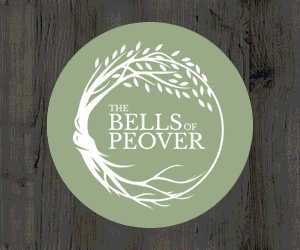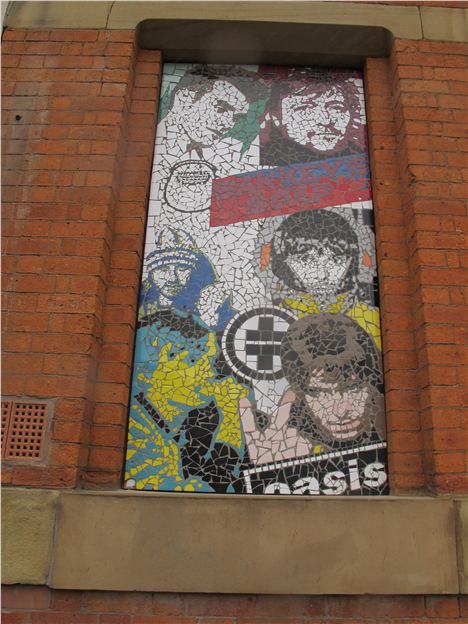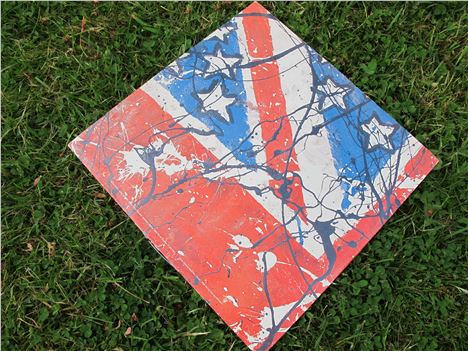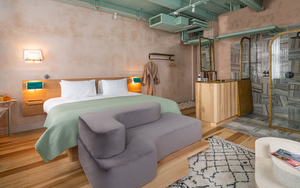Simon Spence has written 'the definitive story' of The Stone Roses. You can win copies here.
The book has already been acclaimed a classic piece of music literature by everyone from impartial critics on 6music to fans with a deep and enduring love for the group.
In the second of of four extracts, that for space reasons couldn't be included in the final book, Spence discusses the origin of the Madchester 'look'. Read the first extract here.
BOOM: 23 November 1989. The Roses and the Mondays together on Top Of The Pops. The Roses with Fools Gold and, following the success of the Paul Oakenfold/Vince Clarke remixes of Wrote For Luck, the Mondays with Hallelujah, the lead track from their new EP, Madchester (produced by Martin Hannett). It was a watershed moment for both bands and the tipping point for a city bursting with musical vision and entrepreneurial panache.
While the Roses had the everlasting jewel of Spike Island; during the media blitz focused on the city in 1990 and 1991, they were the band who appeared to capitalise least - not just musically (releasing just one single in those two years, One Love) but also commercially. In the Madchester boom years (Dave Haslam, for his book Manchester, England, counted that the NME ran 15 Manchester-related cover stories in 1990) the success stories were to be found elsewhere.
It was a gold rush, and, fittingly for a city with such a rich history in the textile trade, many of those who made their fortune were in the rag trade - as Madchester quickly became as much about the look as the music. For many, the cloth was mightier than the chord. T-shirts sales were a massive money-spinner.
Branding Fortune
The boom hinged on a word: Madchester; a catchall phrase, similar to the Swinging Sixties, that perfectly described this golden age of Mancunian cultural world dominance. Nowadays that sort of branding would cost many thousands and require a team of top consultants. In 1989, highlighting the high-wire nature of the whole period, the word came to be as the result of a mistaken keyboard stroke. It was Keith Jobling, one half of The Bailey Brothers, best known at that point for making videos for the Happy Mondays (now the man behind the city’s multi-million pound Sharp Project), who made that stroke.
“My partner in the Bailey Brothers was a guy called Phil Shotton,” said Jobling. “And we were writing a music driven film script called the Mad Fuckers [later, in a radical different format, the basis for the film, Shopping, in 1994], about car thieves. We had a conversation with someone who said, ‘you’re going to have to be a bit careful because in the script you keep referring to Manchester and your problem will be if someone recognises themselves in the script.’ They suggested setting the film somewhere fictional. I remember spelling the word Manchester wrong and looking at it, and thinking, fucking hell that’s actually pretty good: the word Mad and chester, just swapping the N for the D, and because the film was called Mad Fuckers, actually Madchester, Mad Fuckers, yeah… yeah.
“It was around as a word for about a month, six weeks or something, and we gave a version of the script to [Tony] Wilson and he just went ballistic,” added Jobling. “He made Shaun [Ryder] put it on the Madchester EP [that originally was going to be called Rave On]. Shaun wasn’t very happy about it. Wilson basically just stole our word and ran off with it and used it as a marketing tool. It ended up being on the front of Newsweek and becoming part of culture. T-shirts were becoming this big thing and we [The Bailey Brothers] thought, oh we’ll make a few quid out of T-shirts. We did two: ‘Madchester’ and ‘Just Say No To London’. We didn’t make a penny but the word took off.
“The word was an accidental stumble but it did sum up an atmosphere,” said Jobling. “You used to walk around Manchester and it stunk of draw everywhere you went, absolutely seeped in marijuana. In the Northern Quarter you’d go into some record shop and it just stank of skunk. It was like a lawless period, very hedonistic, it did go a bit mad. It was funny and it was genuinely exciting. For 18 months, two years, it did feel like the Summer Of Love. When we did the video for Wrote For Luck I think we had three or four murderers in the video, but they were on E so it wasn’t a problem - they were kissing and cuddling you as they came in. It was a very vivid, intense period of weird stuff happening - the genie was out of the lamp.”
“When then they did the joint Top Of The Pops, their crew was with our crew in the Dry bar [the then newly opened, Factory-owned, bar on Oldham Street – still there] watching it together,” recalled Anthony Donnelly, who with his brother Chris was heavily associated with the Happy Mondays T-shirt operation. “The Hacienda had brought us all together. We were all intrinsically linked.”
“On Top Of The Pops, the Mondays looked like they’d been out and been shopping and bought Lacoste sweatshirts and stuff,” said Chris Donnelly. “From a commercial point of view it was easier to pinpoint the Roses ‘look’ and say that’s acid house. The Mondays look was more laddy. For a fan base, it was easier to replicate the Roses look.”
The Donnelly brothers, having been supremely clothes conscious since their days on the terraces (Manchester United), were now moving into fashion. They had played a crucial part in making the Mondays’ hometown show at the Free Trade Hall [on the same night as the Roses played their Alexandra Palace gig - five days before Top Of The Pops] such a memorable night. The brothers had also organised Manchester’s first illegal rave, the legendary Sweat It Out in October 1988. They were also T-shirt bootleggers. “We were the people who did a Michael Jackson face in green and we got the print wrong, so we could only sell the T-shirts at night,” laughed Anthony.
“We did bootleg other bands but it was an official bootleg we got asked to do for Factory Records for the Happy Mondays’ Free Trade Hall,” said Chris. “If someone is getting bootlegged the best thing to do is do the bootlegging yourself. Then you’re selling T-shirts outside, you’re getting money back from that - but you’re also getting money from the official merchandise on the inside.
“The bootlegging, with permission of the Mondays, led to us going into clothing with [their own label] Gio-Goi,” added Chris. “There were companies out there cashing in on the commerciality of our scene which gave us the hump, so that was a factor in us deciding, you know what, it’s not about bucket hats and Kickers and Wallabees; it’s a real scene for the people who know - and that was a catalyst for us to start the brand, to right a wrong.”
The Roses, via their tour manager - Steve Adge, had asked the Donnelly brothers to take control of the merchandise for Spike Island. “Steve had been coming to see us and we got an official approach to say, right Gareth [Evans, Roses manager] wants to meet you and wants to discuss you doing the merchandise for Spike Island,” said Anthony. ”We get Securicor to come to the office because we’d got delusions of grandeur and we said, right we want De La Rue machines. What for? We’re doing this gig and it’s going to take hundreds of thousands of pounds on merchandise. We were putting a plan in place.
“So then the meeting is set up between me, Chris, and Gareth in Knutsford. We go to the meeting as planned, but apparently this Gareth is a bit weird. We drive out there, and what can only be described as a Benny Hill chase ensued, with us and Gareth. We’re only there to do the merchandise and this geezer won’t even speak to us. Spike Island is upon us and we’ve got to get it ready. Maybe we’ve bought something, maybe we haven’t, maybe we just want to do it - but we’re firm friends with the lads [Roses] now and we want the money. Like everybody else, finally it’s landed and there’s a fortune out there.
“So we end up chasing Gareth, throwing soap at him in Boots [the chemist],” added Anthony. “Boots had got a door from this street to that street and we’re chasing him through Boots over the merchandising. It was Tim Mulryan who put us together with Gareth. He was the manager of Steve Coogan; Tim was another one of our happy ecstasy friends who’d drop in. Then it gets a bit nearer the gig, and it’s not happening. Tim’s fuming. Gareth’s gone really weird. In the end, at Spike Island, we just went to watch the gig. We would have made a good job of it [the merchandising] – we were notorious at the time, yes, but our integrity was never in question. If we said we were going to do something we would deliver.”
Evans kept control of the Spike Island merchandising, using New Line Promotions to make the T-shirts. It was estimated close to 30,000 were sold at Spike Island, plus thousands of ‘Reni hats’. Even though the hats and the Roses ‘lemon’ T-shirt became chief signifiers of the era, how much money the band made from such items was negligible.
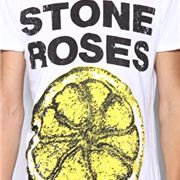 The Stone Roses 'lemon' T-shirt
The Stone Roses 'lemon' T-shirt
More Than Your Average Joe
Financially, the main beneficiary of the Madchester fashion boom was local brand Joe Bloggs. The Happy Mondays, New Order, Inspiral Carpets and The Charlatans all appeared in a number of music press articles, and on TV, sporting Bloggs - and for many it appeared Bloggs had invented what became known as the ‘baggy’ look.
Started in 1985, the company was born out of a small family-run concern. The Ahmeds had traded on market stalls in the 1960s and 1970s and progressed to owning four retail stores in Burnley. A younger generation had moved into the family business, notably siblings Shami and Bushra, with fresh ideas and ambitions. Shami came up with the name Joe Bloggs and moved the company away from retail into wholesale, with an operation run from Bury New Road on the Strangeways/Ancoats border of town.
Bloggs first hit the headlines in 1986 after launching a 25-inch flared jean. Their 1986, 21-inch, wide-legged flares would feature in the 1996 V&A Street Style exhibition, tagged as ‘cheeky, baggy and androgynous; a key part of the Madchester raver outfit of 1987-1988’.
In 1987, Bloggs became the first British label to enter the UK’s top ten revenue earners in terms of denim jeans. Ever-inventive, Shami had got a pair of 45-inch flares in the Guinness book of world records as the ‘widest jeans in the world’ – and two new styles; the ‘ventilation’ jean (heavily cut and slashed denim) and the one size fits all ‘baggy’ jean, were both massive hits.
Bloggs also specialised in heavily-logo’d sweatshirts, hooded tops and T-shirts – every punter a walking billboard. The Roses did more to popularise the ‘baggy’ look than any other band, but uniquely among the Manchester groups were never seen in Bloggs. The Mondays didn’t much care for Bloggs either, and had been led to the label by Tony Wilson for a segment in a Madchester documentary that Granada producer Steve Lock was putting together. Bloggs told the Mondays to help themselves, and their whole crew turned up and walked out with a vanful of the clobber.
“I never got the Bloggs things,” said Keith Jobling. “I wouldn’t say the Mondays were obsessed about how they looked, but they definitely cared. They got the fact that they had to have a look for it to make sense. We wore a lot of stuff like CP and Stone Island, it was all Italian street stuff. Bez would have a Stone Island jumper on and it would be ripped from a fight, but he’d still wear it. Shaun’s always been almost like a rap star. He’s always had this thing about, ‘this coat’s worth £2,000’. I’d ask, did you pay that? He’d say, no, no I paid £100 for it but it was in the shop for £2,000 and I gave him £100; I’ll give him the rest later.”
“The Mondays agreed to do the shoot for Joe Bloggs and when they watched that [Granada documentary – Celebration: Madchester – Sound of the North, 1990] they went mental, not happy,” said Anthony Donnelly. “Bloggs had cleverly said, let’s get the Mondays in and get them in all the Madchester gear to endorse our product: power to them. If we were as switched on, business-wise, as they were, watching loads of kids create something, and we had the power to rinse it… I’m not saying we would do it, but if they made a million pounds from it, give us our corner.
“It’s like Leo [Stanley at the Identity shop, based in Afflecks Palace, and famed for the AND ON THE SIXTH DAY GOD CREATED MANchester T-shirts and other variations of],” added Anthony. “Leo’s our best pal but we can all do that can’t we? We could all go out today and do our Amy Winehouse T-shirts [I interviewed the Donnelly brothers for War and Peace the day after Winehouse’s death]. The thing we wanted to hold on to, and why we think the crown belongs to us, is we were really doing it, we were involved in it - we were orchestrating it. All the things that were going on - we were there. It was easy to ride it. We were the scene - Joe Bloggs was ripping off the scene.”
Competition
Gio-Goi made their first T-shirts in collaboration with the Happy Monday’s famed record sleeve designers, Central Station [who suggested to the Donnelly brothers they call the brand Shit Clothes]. Central Station’s T-shirts for the Mondays were in a different class to the rest – graphically – and the early Gio-Goi T-shirts (alongside the Mondays T-shirts) are the true classics of this period.
Peter Hook appeared on the front cover of the NME in one of the first Gio-Goi T-shirts. The Donnelly brothers then hooked up with designer Jonathon O’Garr, who dressed Adamski, as seen in the Killer video [the track was recorded in 1989 but a massive acid house No 1 crossover hit in early 1990], and developed a full range of Gio-Goi clothing that garnered an immediate reaction.
“We didn’t do seasons,” said Chris. “We’d just made stuff constantly, brought it in and put it on the floor. The shops loved us because they could come down and as fast as they could buy it, they were selling it, and they’d be down the next day for more gear.”
“This went on for three years,” said Anthony. “There was buckets of money and we were off our nut. I remember Leo [Stanley] came in to the office and was picking loads and loads of gear. We were all sat smoking pot and he had to write out his own order form because none of us knew how to fill it in. Looking back now, we went through that whole Madchester period and never recognised what we had. The whole world was looking at us and we just thought we were going on a night out. We had all this thing going on around us, which was us, but we were totally oblivious.”
Bushra Ahmed (who along with her brother, Shami, ran Joe Bloggs) said her company enjoyed a “friendly rivalry” with Gio-Goi. In a deeply fashion conscious city, there remains a lively debate over where Bloggs fits into the history of the Madchester look.
“We started that whole look off for the bands,” said Bushra (who now presides over the hugely successful, and multi-brand, Juice Corporation http://www.juicecorporation.co.uk/). “The bands weren’t wearing all these big baggy sweatshirts and tops and jeans until Bloggs. Shami was PR driven. It was all about ideas and the better the idea, the better the sales. We brought back the widest jeans in the world purposefully. It was just another take on a normal 1970s flare but we wanted to make it a bigger story. With the baggy jeans we worked with designers and manufacturers and just came up with a new look of a jean. The bands and the celebrities latched on to us because the brand was becoming so popular.
“We were dressing all of the new bands that were coming up [in Manchester] free of charge in our product,” Bushra added. “A lot of these bands were off the street, they had no money, so free of charge sounds good - and they took as much as they wanted. Joe Bloggs was so new and they were the first ones wearing it, so that made them feel a bit special. For us, when you’ve got New Order in it, the credibility boost was just enormous. It was great PR - and then when the bands got more popular, the public went mad. The Happy Mondays and Inspiral Carpets were massive for us.”
As for the inspiration behind the Bloggs ‘baggy’ jean, Bushra is typically plain speaking. “In the 1970s the skinheads were wearing parallels,” she said. “We adapted it. We brought out a wider one. All our ideas were coming in from the 1960s and 1970s, and all we were doing was updating those looks to fit the 1980s and 1990s. We were looking for new ideas all the time and Shami was a PR machine, coming out with all these ideas every five minutes. He was thinking 24 hours a day what stunt he could pull next.”
I got to ask Shami one question for War and Peace: Did he take inspiration from the fashion scene emerging at the Hacienda, or taken note of the fashion brave buying up flares and semi-flares from Phil Saxe’s market stall in 1983/84? “No,” Shami said. “It was a fashion idea that worked and we sold a lot.”
“The Hacienda wasn’t Shami’s scene and the brand was never targeted at the Hacienda,” said Bushra. “Joe Bloggs was never targeted at the indie crowd. It just happened that the indie market latched onto the brand. We were lucky with it. It was the right time for us; people were a bit bored and something needed to happen and it happened.”
The Bloggs wholesale operation, on Bury New Road, became something of a Mecca. It was trade only, but on Sunday the company would open the doors to punters with the caveat that they had to spend a minimum of £75. There were “queues around the block”, said Bushra. “We used to have security on the door; it was just like a club, one in, one out.”
Copycat, Copycat
Although indelibly tied to Madchester and the rave scene, and proud of the fact, as Bloggs exploded nationwide in 1989/90/91, any cult appeal they may have had quickly became diluted – and the brand themselves suffered from copycat manufacturers.
“It got to the point where the market was saturated,” said Bushra. “It was flooded. The counterfeits spoilt quite a lot for us. We had so many fakes going around - you could buy a fake for half the price. The quality was terrible but if your a fan of the brand and you want to wear it because you’re favourite band is wearing it, and you can’t afford full price, you buy a fake.”
Bushra and Shami moved on – coming up with newer, more bling ideas, such as inventing the world’s most expensive jeans; a $200,000 diamond encrusted pair. They targeted a new market, dressing superstars like Prince, cricketer Brian Lara and boxer Prince Naseem. “At one point Take That had it on,” said Bushra. “Peter Andre in the Mysterious Girl video – so it was completely on the other side of the musical spectrum. We targeted sports a lot more; football and boxing. It wasn’t about the raving and the big baggy pants anymore.”
Nonetheless, Bloggs did much for the local economy in the Madchester boom years - with all their denim proudly manufactured in the area. At one point it was estimated the company was worth £60 million.
 Kids wearing Joe Bloggs, Manchester, 1989
Kids wearing Joe Bloggs, Manchester, 1989
Another winner in the Madchester gold rush was the Inspiral Carpets, a band who seemed to embrace the Bloggs brand. Managed by Anthony Boggiano, who had worked for the Roses manager Evans at The International in the mid-1980s; it was a popular rumour that the Inspiral Carpet’s T-shirts (most famously their ‘Cool As Fuck” one) outsold their records.
“As far as the Roses were concerned, the Bloggs people were following them,” said Boggiano. “For the Inspirals, Joe Bloggs was just free clothes. At that stage they were earning fuck all money, no income, and when someone says right come and choose the clothes you want… the Mondays were doing the same thing as well. Bloggs got a good plug out of it. The Inspirals went on Top Of The Pops a few times wearing the gear.
“It was bullshit, though, that the Inspirals’ T-shirts outsold their records,” Boggiano laughed. “They did sell a lot of T-shirts and it was a good source of revenue but they didn’t sell as many T-shirts as records. It used to really annoy the band that people thought that - but we started the rumour, bragging about T-shirt sales.”
I never wore Bloggs. My Madchester fashion guide was a handsome Sheffield ‘Blade’. My first pair of huge parallels (with a slight flare) bought in that city: probably Bloggs copies. In the mid-90s, I enjoyed a brief moment in the fashion sun myself - alongside the infamous stylist, Barnzley, at the world-renowned shop: Acupuncture, Soho.
When I moved to Manchester in 1998, I was led to the door of the then last Madchester fashion man standing – Steve Caton, owner of the ultra-hip independent clothes shop, Geese. The shop had supplied the city with clothes and labels that were both individual and high-class during the boom years – a real hipster outlet, far removed from the Bloggs phenomenon. I still treasure a couple of items I bought from Geese in the late 1990s: an Adriano Goldschmied shirt and a Generic Costume jacket. Although now sadly defunct, Caton’s right-hand man at Geese is still around; running the city’s impressive Ran shop.
Finally, majestically, Gio-Goi, re-launched themselves in 2005 – and set off on another hot-streak that continues to this day: the label being sported by Ronnie O’Sullivan, Pete Doherty, Amy Winehouse (RIP), Plan B, Rihanna, Arctic Monkeys, Mike Skinner and Kasabian, among a host of influential luminaries. It was proof, if anymore was needed, that, yes, the crown did belong to them. Their website is a must-see.
The Donnelly brothers are true legends; kings, but I’m sticking with my prince charming, Barnzley. It was love at first sight. He put the smiley face in acid house, and had a huge influence on the Japanese street fashion giants of the 90s, Hiroshi and Nigo. He now co-owns A Child of the Jago: a brand and shop founded in 2007, in partnership with Joseph Corre (famed for his Agent Provocateur label and shops). It’s another must-see.





